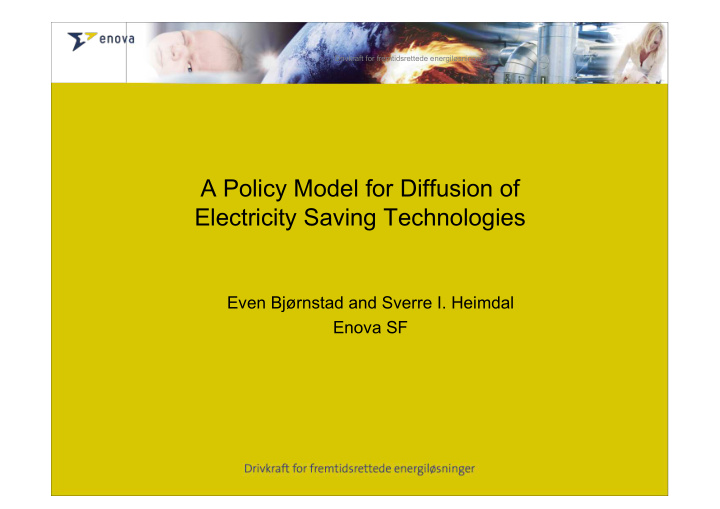



Drivkraft for fremtidsrettede energiløsninger A Policy Model for Diffusion of Electricity Saving Technologies Even Bjørnstad and Sverre I. Heimdal Enova SF
The Norwegian Energy Sector • Dominated by rich renewable energy resources. • Cheap hydro power has resulted in – Electricity intensive industry structure – Electricity as the dominant space heating source • World’s highest electricity consumption per capita • Challenge: How to build flexibility and increase energy efficiency in a strong economy with moderate energy prices?
The Norwegian Energy Market with a Strategy Perspective • Factor condition – Reduced fear of shortage of supply - – Challenges in some regions. Competition • Demand – Energy use in residential sector marginally declining – Energy use in industry and service Input Demand sectors increasing, but with less Factors growth • Structure and rivalry – Energy prices will rise due to increased import/export capacity of Clusters electricity • Related and supporting – New building codes – Climate politics
Enova SF tools to promote energy efficiency • Industry – Investment support • Public and commercial buildings – Investment support – Demonstration projects • Households – Information, Advice – Investment support • Children and Youths – Television and Schools – Internet • Targets for Efficiency and Renewable production are comparable to other European countries
Introduction of air to air heat pumps - The 2003 exit Sales Air-to-air heat pumps 1993 - 2008 100000 76832 80000 73301 65210 The 2003 governmental support scheme No. of units 60000 51448 40000 32754 32012 18974 20000 4637 499 859 585 759 1195 1160 1648 1671 0 Year
The Enova SF toolbox and planned behaviour theory Facts • Self efficacy Marketing • Awareness • Social influence Enova SF Motivation • Attitudes • Intention Financial support • Self efficacy Energy Result • Behaviour
Consumer groups and technology diffusion • Innovators (2,5 %) Early market: – Technology enthusiasts, price not relevant • Risk takers • Early adopters (13,5 %) • Frontrunners – Visionaries, strategic advantage • Strategic • Early majority (34 %) Mainstream market: – Peer reference, adopt with willingness • Risk averse • Late majority (34 %) • Seeks references – Sceptical, adopt out of necessity • Driven by current problems • Laggards (16 %) • Analytic – Still using black and white TV Early adopters should be supported to reduce uncertainty for mainstream market consumers
Residential sector: Diffusion of new technologies The Main stream chasm market III IV Early market V II I
Making 2 mill. households to take actions Building codes / Labelling / Appliance standards Motivate / Communicate to initiate actions Advice / Trade fairs / Internet / Brochures / Magazine Demonstrate Support Time Recommend { Market } ”Exit-market” Immature markets technologies Immature { Target } Develop markets Best available technology Highlight promising Marketing { Measure } Financial support Build knowledge Support Competitions
Investment Support for Households • Launched August 2006 • Supported technologies: – Pellet stoves – Pellet boilers – Central control systems – Brine to water heat pumps – Air to water heat pumps – Solar collectors (From August 2008) • Status May 2009: – 32.000 applications – 10.000 projects completed • There is filed a complaint against the support scheme that is expected to be concluded by ESA in June or July 2009.
A shift for air to water heat pumps Sales Air-to-water heatpumps 1993 - 2008 5000 3985 4000 3318 The 2006 governmental support scheme 3000 No. of units 2383 2000 1000 655 523 509 388 119 133 227 189 98 76 32 43 119 0 Year
Public subsidies – must prices increase? Supported air-to-air heat pumps 2003 3000 4600 Average grant [NOK] 2500 4400 Units installed 2000 4200 1500 1000 4000 500 3800 0 Feb Mar Apr Mai Jun Jul Aug Sep Okt Nov Des Month
Conclusions • An Energy Agency should plan its initiatives in stages – It’s easier to work with markets than against markets – The Agencies’ brand value may be good backing • Consumers are not homogeneous – Early adopters should be supported to reduce uncertainty for mainstream market consumers • Crises may be helpful – if they don’t last to long • Entry and exit are essential – Entry as a lightning from clear sky – Exit as smooth as possible • Social marketing works
Recommend
More recommend